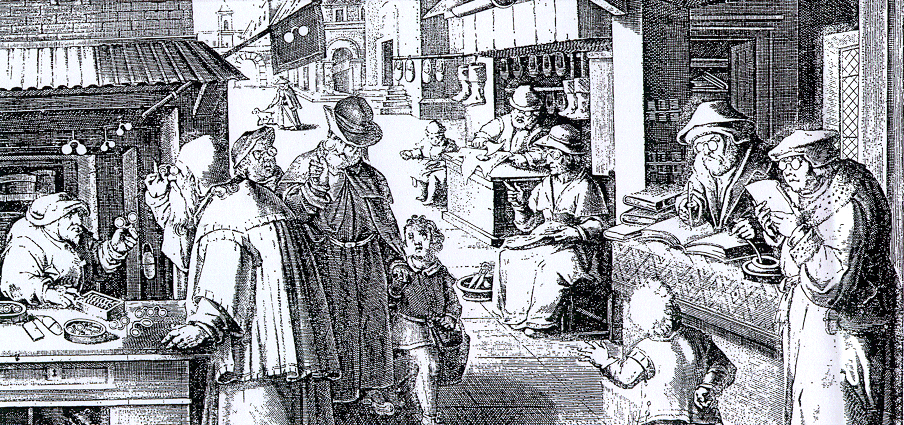I originally did the research and made the reproductions in 2003 when I was involved in reenactment. Most of the ” ‘tude” was aimed at a couple of stolid purveyors of Fakelore.
Fakelore or pseudo-folklore is inauthentic, manufactured folklore presented as if it were genuinely traditional.
Richard M. Dorson 1950
Or as often seen in the worlds of reenactment, fakelore is mistaken for fact, so often repeated it becomes entrenched. So when one idiot tried to have me ousted from an event for my entirely accurate replica specs, I did the research below. Printed it off and handed it to her. She still wasn’t happy so I published it online. For several years, this and the howto make your own article were the first and only online.
1400 – 1500
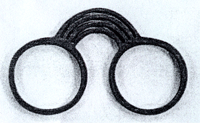
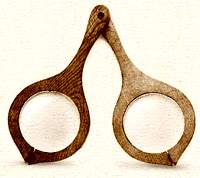
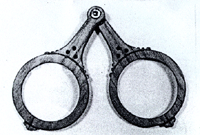
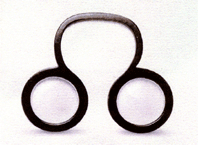
1500 – 1600

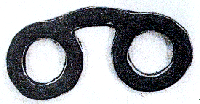
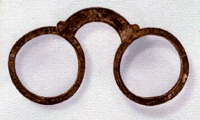
“[…] we do know they (leather frames) were made in London and that they were met with hot resistance from the elder freeman of the Worshipful Company of Spectacle Makers. This company administered the law and imposed fines on people making or selling leather frames, empty or glazed.” [1]
Spectacles, Lorgnettes & Monocles
By D C Davidson & R J S MacGregor – Published by Shire Publications – 2002
1600 – 1700
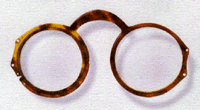
these are a particularly interesting example that show two holes for the string to be tied – as my DH found in wearing the single bar specs in the demonstration, tieing his string to the lacing loop and to the rim closure provided a more stable fit.

This may be one of the first examples of Leonischer wire rimmed frames – made all in one piece of bent/domed sheet. The nose area is commonly padded with wrapped silk thread. This design changes very little over the next 4 centuries and becomes the standard pince-nez of the 1900’s.

made with brass wire and repaired with silk thread and brass wire. With matching brass engraved case.

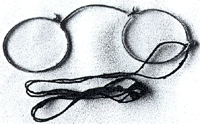
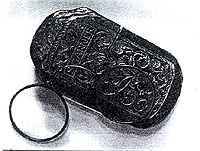
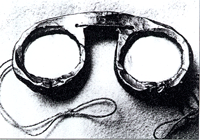
Historical Documentation – Paintings, engravings actual documents and stuff…
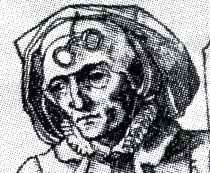
“A german woodcut of an old woman spinning with spectacles tied to her head-dress. c. 1550 (V&A Museum)
“A Handbook of Costume” by Janet Arnold
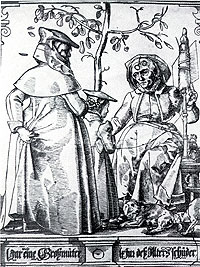
This is the most touted image for frames – and the ones I made a reproduction of in sterling silver – everyone quotes and refers to it and who am I to buck with tradition (YES! You may replace the b!). So here’s the guy with the strings round his ears, single bar, top lacing loop, dead centre side closures which may be either wire wrapped or screw bolted ( I actually did find an engraving proving bottom screw bolt closure for 1540 – but damned If I can remember where!!!).
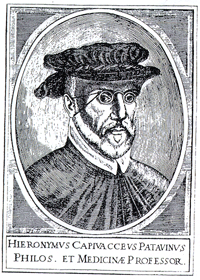
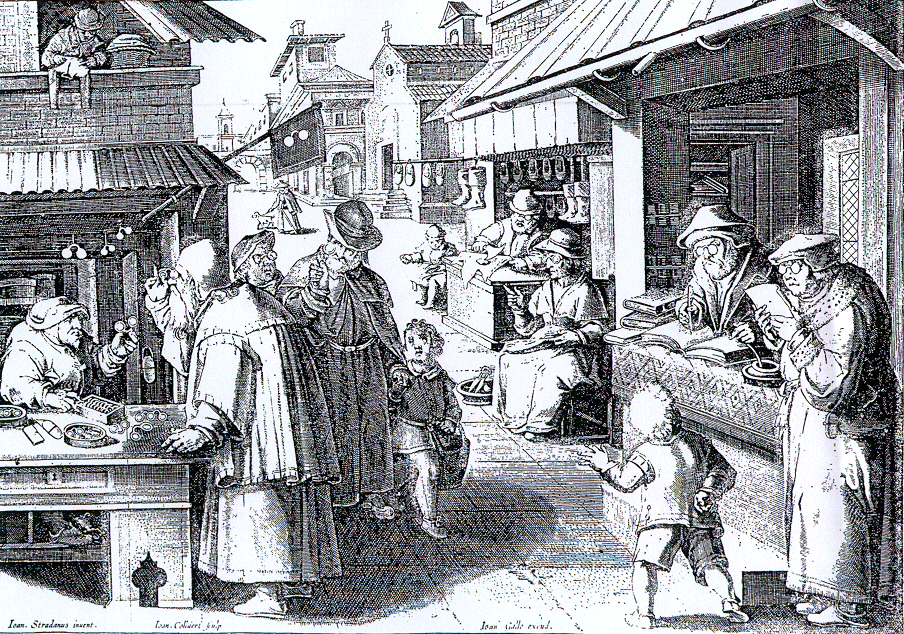
c. 1600 engraving of a spectacle shop and market
What I love about this engraving is that it shows the extensiveness of who was wearing specs! Absolutely everyone. Now, yes there is documentation from the Spanish saying all the courtiers were wearing specs the sizes of dinner plates to show intellectual they were – “BUT” cry the Mavins, where is the proof that anyone else under a nobleman did? Well, here! Tailors, bootmakers, booksellers and passers-by. And wearing them to walk around in – thereby for nearsightedness! I stick my tongue out at the lot of you!
These next plates are taken from Fashions in Eyeglasses by Richard Corson. Unfortunately he does not state where he got the engravings from. BUT! I have found images of some of the real specs. So, although these are still on par with Norris for being possible redrawings – they are pointing in some very clear directions that do have physical backups.
- 1510 Italian
- 1500 – 1550 English made from horn
- 1500 German – made from horn
- 1583, German (Dresden). Leather and horn.
- c. 1600 German. Leather and horn. From a manuscript in Nürnberg.
- c. 1600 German. Leather. From a manuscript in Nürnberg.

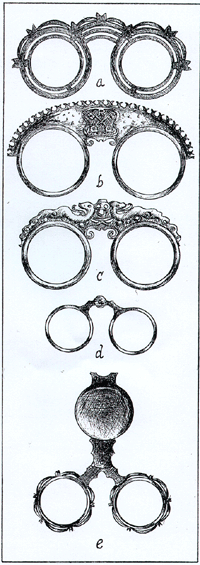
- 1500 – 1600 German, Spectacle makers’ ‘masterpiece’. The same designs for the master peices continued to be used in Nürnberg until 1723.
in other words it was an exam peice! Complete this to standard and you get in the guild – it works the same today for silversmiths. - 1500 – 1600 German, Spectacle makers’ ‘masterpiece’ with the Regensburg coat of arms.
- 1500 – 1600 German, Spectacle makers’ ‘masterpiece’.
- c. 1600 German.
- c. 1600 German. Folding eyeglasses of horn. From a manuscript in Nürnberg. Whether the design was actually made or not is not certain. They were held with the lenses downward, the handle in front of the forehead.
- 1600 – 1700 German Frames of heavy brass wire tied with binding thread to hold the lenses firmly in place. This style continued in use throughout the eighteeth century.
- Rigid frames made of leather
- End of the century Chinese. Made of horn. Small holes at either side of the frame are for attaching cords.
- End of the 1600’s. Spring frames with attached spring bridge.
- Perspective glass with silver mounting. These were used by fashionable gentlemen throughout the century.
- Frames made of brass wire. After the lenses were inserted, the frames were pulled tight and tied with binding thread. Not used before the 1600’s.
- 1687 German, Spectacle makers’ ‘masterpiece’ – see the image below of the actual spectacles!


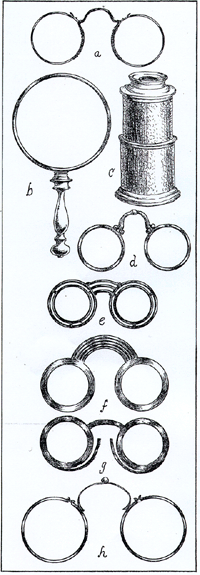

- c. 1700, German. Spring frames with wire winding, tied with binding thread. Made in Nürnberg
- Last quarter. Brass magnifying glass, used in England.
- End of the century, Swiss. Prospect glass, used in England. The outer body is of green shagreen (shark’s skin), the single drawtube is covered in green tooled vellum, and the mounts are of ivory, that for the object-glass bearing the inscription ‘Giuseppe Moschino in Geneva’. (Science Museum London)
- 1677, French. Pivoted eyeglasses. Also worn in England.
- c. 1600, German. However, they were probably known as early as 1550. Double horn frames. The bridge, made of curved strips of horn, gives enough flexibility to hold the glasses on the nose.
- 1675, English. Slit frames to give slight flexibility.
- c. 1600, German. Horn rims, side springs also of horn.
- c. 1630, German. Gilded silver. Made in Augsburg.
Check out the article on How I Made Simple One Bar Specs 1400-1700
